Beginner basics for flats fishing
Five tips for becoming a better flats angler
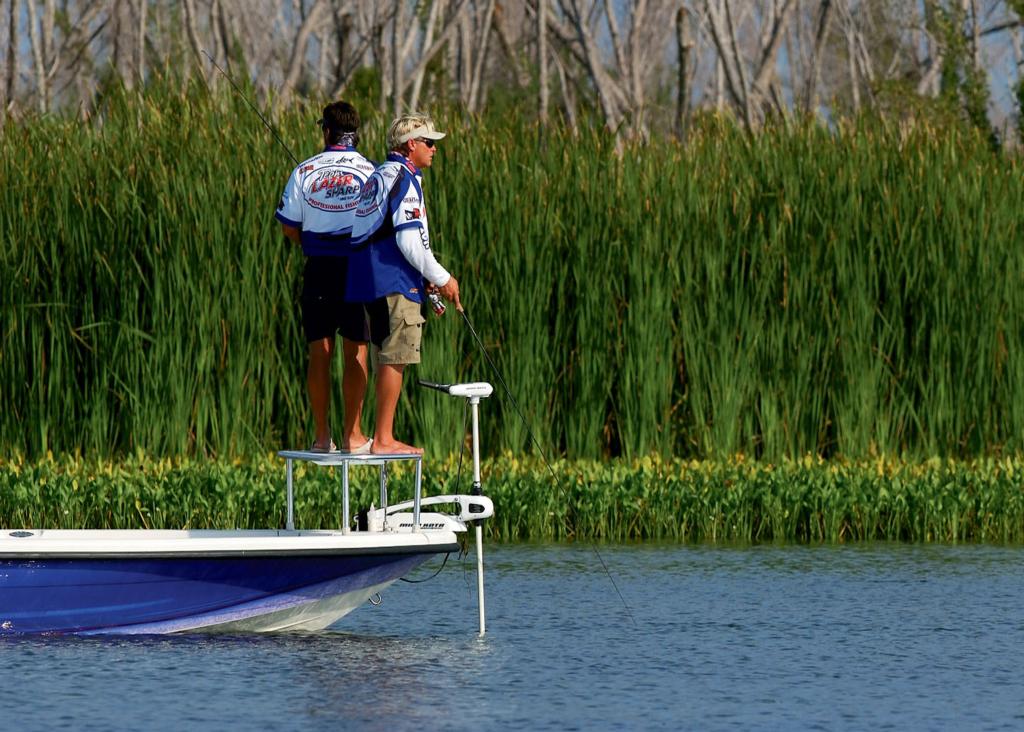
————————————–
Editor’s note: This article originally appeared in the January-February 2007 issue of FLW Outdoors Magazine, Saltwater Edition.
————————————–
For the beginning inshore angler, there’s nothing quite as intimidating as a vast flat – a limitless expanse of seemingly featureless water that supposedly holds fish.
Locating inshore species such as trout, redfish, flounder and snook in such an endless system can be a challenge for any angler, especially the neophyte. Reactions to such a daunting task run the range of: “It all looks the same,” to “Where do I begin?”
FLW Outdoors Magazine summoned the help of five inshore-flats specialists to help the beginner address some of these startup issues.
Most of these experts are veteran saltwater guides that see the common mistakes novices make on a regular basis and can recite the beginner’s list of most frequently asked questions by heart.
Andrew Bostick: Become a sponge
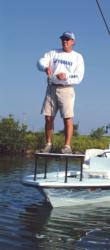 Andrew Bostick of Marco Island, Fla., has been guiding in the Everglades National Park and the Ten Thousand Islands area of Florida for more than 20 years.
Andrew Bostick of Marco Island, Fla., has been guiding in the Everglades National Park and the Ten Thousand Islands area of Florida for more than 20 years.
In Bostick’s opinion, to cut the learning curve of flats fishing to a fraction of the time, the only substitute for time on the water is to hire a guide.
“I know that sounds trite and self-serving,” Bostick said. “But if you really want to expedite the process, hiring a guide will help you learn at light speed.”
Some folks see guides and charter captains as party-boat meat hunters, but as Bostick pointed out, there are a lot of guides, especially inshore guides, that specialize in teaching technique.
“Shop around and find someone in your area, or the area you want to learn about, who is geared toward one-on-one instruction, and make the most of it by asking a lot of questions,” he said.
Bostick advised anglers to get involved in a local saltwater club, such as a Coastal Conservation Association (CCA) chapter, and attend the guest speaker sessions, which often feature well-known anglers and guides from the area.
“Also, there is a wealth of information in magazines, books and videos about flats fishing, especially in Florida,” he added. “Become a sponge and absorb as much information as you can.”
C.A. Richardson: The right tools
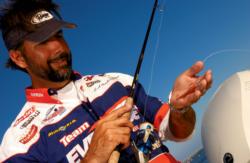 C.A. Richardson, a full-time guide from St. Petersburg, Fla., who also runs Flats Class fishing seminars (flatsclass.com), has helped many new flats anglers get hooked up with action in inshore shallow water.
C.A. Richardson, a full-time guide from St. Petersburg, Fla., who also runs Flats Class fishing seminars (flatsclass.com), has helped many new flats anglers get hooked up with action in inshore shallow water.
Richardson revealed the most common mistake he sees among anglers that come to him for help is that their terminal tackle is way too cumbersome.
“I see a lot of the big, surf-casting kinds of rods loaded with 20-pound-test monofilament,” he said. “Those are great if you’re trying to heave 2 ounces of lead 100 yards off the beach, but they are inefficient in the flats.”
Richardson suggested anglers look into a moderately priced, 7-foot, medium-action spinning rod rated for 8- to 15-pound line. He recommended matching the rod with a medium-action spinning reel spooled with braided line in the 10-pound-test class.
“The object of this setup is casting distance,” he explained. “In Florida, long casts are mandatory. In addition, the longer your casts, the more real estate you’re covering and the better your chances are for a bite. A nice medium-action rod with thin, 10-pound-test braid is going to sling tiny baits a lot farther than a heavy-action surf caster with stiff monofilament.”
Complete the outfit with 3 feet of 25-pound-test fluorocarbon leader.
“Forget about steel leaders and swivels,” he added. “I see a lot of those from beginners, too. Fluorocarbon for leader material works great. Join the braided line to the fluorocarbon leader with back-to-back uni-knots (netknots.com).”
In terms of lure selection, Richardson advised beginners to stick with 1/2-ounce weedless spoons or 1/8- to 1/4-ounce jigheads paired with 3-inch Berkley Gulp Shrimp. His knot choice for tying the lures to the leader is a loop knot.
“Don’t worry about fancy topwaters or soft jerkbaits that require the angler to impart the action to the bait in the beginning,” Richardson offered. “Stay with baits that will do the work for you – reeling a spoon easily through the water or bumping a Gulp along the bottom. These baits will catch just about everything that swims inshore, especially trout and reds.”
Tommy Ramzinsky: Find the bait
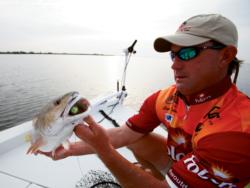 If you follow tournament redfishing at all, Tommy Ramzinsky and Todd Adams of Rockport, Texas, need no introduction. In addition to being tournament pros, both anglers guide out of Rockport.
If you follow tournament redfishing at all, Tommy Ramzinsky and Todd Adams of Rockport, Texas, need no introduction. In addition to being tournament pros, both anglers guide out of Rockport.
Ramzinsky noted where flats beginners are likely to get bogged down is by fishing a lot of dead water that seems to look really good.
“Bait, bait, bait,” Ramzinsky remarked. “It’s all about bait. You can have the best cover and structure in the world, but it’s absolutely worthless without bait.”
Ramzinsky said he believed the best way to find bait is to cover water looking for it. Visible mullet schools are Ramzinsky’s No. 1 flats fish locator.
“Bait is a word that encompasses a lot of things – mullet, shad, pogies, shrimp and crabs,” he said. “Inshore game fish don’t exactly eat the big mullet – so `bait’ might be a bit of a misnomer for big mullet – but big-mullet schools do flush up a lot of bait off the bottom, and other types of smaller baitfish seek refuge inside mullet schools. So in a way, schools of big mullet are like a mobile all-you-can-eat buffet for all flats species.”
Mullet schools often give themselves away by creating noticeable surface disturbances, either by suckling along the surface or jumping and flipping.
“When looking for inshore fish, I can’t stress the importance of surface activity,” Ramzinsky said. “Always pay attention to the water’s surface all around you and always investigate surface activity.
“If you’re having trouble finding bait, try looking for a little off-colored water,” Ramzinsky suggested. “Not dirty water, just water that might be a little more off-colored. Not only are inshore game fish more aggressive in off-colored water, but bait tends to favor it as well.”
Above all, Ramzinsky urged beginning anglers not to waste their time fishing “sterile” water.
“At times, we have huge expanses of super-clear water in our bays here in Texas,” he said. “It looks so beautiful and fishy, but you can fish for miles and never see any bait popping, fish movements or anything – it’s almost sterile. Keep moving. Find where another river or estuary brings in water that is more colored; find the bait and see if your catch rate doesn’t improve drastically.”
David Walker: Trust your eyes
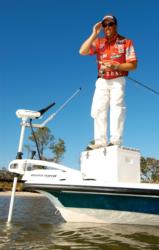 FLW Outdoors pro David Walker is a redfish transplant from Sevierville, Tenn. Although he’s made a career from bass fishing, Walker has also cashed checks in several redfish tournaments.
FLW Outdoors pro David Walker is a redfish transplant from Sevierville, Tenn. Although he’s made a career from bass fishing, Walker has also cashed checks in several redfish tournaments.
Walker has never guided on flats, but his induction into the flats game provides an interesting perspective because his early mistakes are still fresh in his mind.
Like Ramzinsky, Walker opined many beginning flats anglers probably spend too much time fishing water that looks good, but holds few fish.
“When I first started fishing inshore, I was tempted to fish every grassy flat and mangrove shoreline I saw because it all looked so good,” Walker said. “But what I eventually learned is you can fish your arms off in the prettiest-looking water, but if you’re not actually seeing fish or some evidence of fish, you’re just spinning your wheels.”
On the flats, Walker has two different modes: looking for fish and fishing for fish.
When “looking” for fish on the flats, he turns the trolling motor on high and visually scouts as much shoreline and as many flats as he can possibly scan in a day.
“When I’m in that looking mode, I hardly ever pick up a rod,” he said. “The object for me is to see as many fish as possible – not catch them. When other redfish pros see me in practice, I’m sure they think I’m a bull in a China shop because I’m bolting down the shorelines, zigzagging the flats with the trolling motor on high. I’m respectful of the resource; I’m not tearing up grass or anything, but I’m not exactly tip-toeing around with a push pole either. That trolling motor is working overtime.
“I want fish to show themselves,” he continued. “If I spook two or three off a shoreline or see some flashes in a sand hole, at least I know where they live. I make detailed notes about the tide and location of any fish I see.”
However, when Walker returns a day or two later in the official fishing mode, it’s a whole different approach.
“Now I’m in the tip-toe-up-to-the-fish mode, minimizing noise and movement,” he said. “I try to sneak up on the places where I saw fish when I was burning up the bank on the trolling motor and always try to return on the same tide.”
When he slows down and begins to carefully examine a place where he noticed fish, he usually uncovers the key feature the fish are relating to.
“It might be a deeper drop-off along a line of mangroves, a slight depression in a flat, or an oyster crag breaking the current near a creek mouth; there is usually some identifiable feature in the area.
“That’s what I like about flats fishing,” Walker added. “The fish give those types of good places away. It’s a highly visual game, and it took me a while to totally trust my eyes to eliminate water.
“Coming from bass fishing, I’ve always had to fish areas thoroughly to make sure I wasn’t missing anything. On the flats, if I’m not seeing fish activity of some kind, I don’t even bother to fish; I just keep on moving.”
Watts brothers: Subtle contrasts
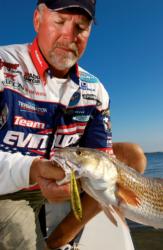 The Watts brothers might be considered the modern-day godfathers of inshore tournament fishing in Florida.
The Watts brothers might be considered the modern-day godfathers of inshore tournament fishing in Florida.
Originally bass fishermen, Greg and Bryan Watts began probing around Florida’s inshore flats about 20 years ago and found a new home.
“Flats fishing is all about subtleties,” Bryan Watts said. “The difference between the novice and the experienced flats angler is the novice looks out across a flat, and to him, everything looks the same.
“The experienced guy looks out across the same flat and sees the higher-percentage opportunities; he can read the different sizes and shapes of the sand holes and the differing water colors that indicate seams and contours along the bottom.”
Watts contends that an important concept flats anglers need to understand is any type of bottom change represents structure to inshore species.
“Pay close attention to contrast,” he said. “Especially subtle contrasts – as contradictory as that may sound – like a slightly deeper area in predominantly shallow water; a slightly shallower area in predominantly deep water; a thicker patch of grass in a barren flat; a barren area in a thick grass bed; clearer water running into muddy water; or muddy water running into clearer water.
“Subtle contrasts and features are feeding stations for inshore species,” Watts added. “Once you find these kinds of places, fish are likely to use them time and time again.”
Putting it all together
By combining these pros’ tips, flats fishing does not have to be overwhelming. Consult a local expert, get into the right gear, spend more time looking for bait and fish activity, and determine what subtleties hold fish in your area. By doing these things, you’ll be farther along in the flats-fishing game than you might think.